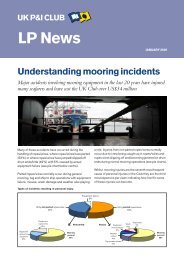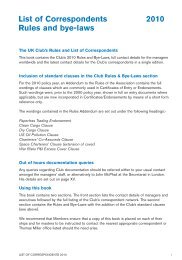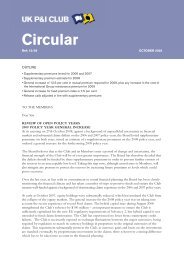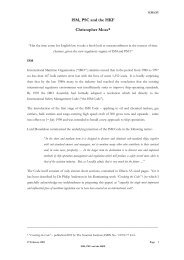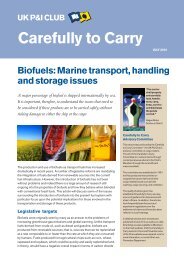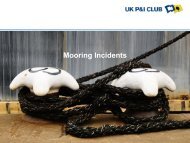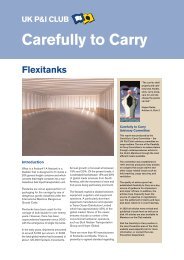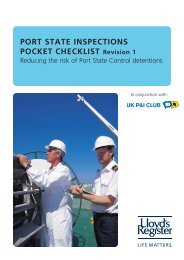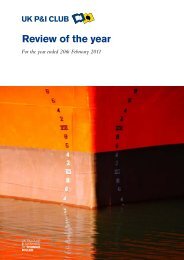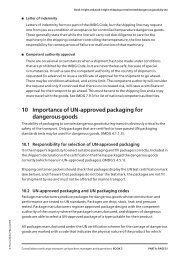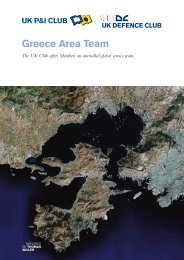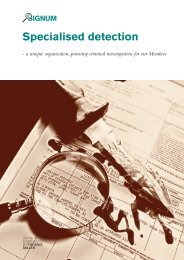Tch B28 - UK P&I
Tch B28 - UK P&I
Tch B28 - UK P&I
You also want an ePaper? Increase the reach of your titles
YUMPU automatically turns print PDFs into web optimized ePapers that Google loves.
<strong>UK</strong> P&I CLUB<br />
Technical Bulletin<br />
NUMBER 28 2008<br />
Enclosed space entry permit<br />
to work<br />
Heightened frequency of enclosed space incidents resulting in the death of both<br />
crewmembers and visitors<br />
Further to technical bulletin 8/2003, the managers are<br />
concerned to note a heightened frequency of incidents<br />
resulting in the death of both crewmembers and visitors<br />
as a consequence of entry into enclosed spaces, or<br />
through the release of noxious gases in enclosed<br />
spaces. These include:<br />
Spain, April 2008<br />
The cargo receiver’s surveyor died on board after<br />
entering an untested hold via an opened access hatch.<br />
The incident occurred despite the surveyor having been<br />
strictly advised by the chief officer and another<br />
crewmember to remain out of the holds until clearance<br />
was obtained.<br />
Indonesia, June 2008<br />
Two shore-based contractors boarded the ship with the<br />
intention of removing sludge from a tank. Unknown to<br />
the crew, they gained access to the tank. They were<br />
not using breathing apparatus, had not taken any<br />
measures to determine the composition of the<br />
atmosphere within the tank, and they were overcome<br />
by fumes and died. It is likely that one of the contractors<br />
entered the space in an attempt to rescue his<br />
colleague.<br />
USA, June 2008<br />
A bulk carrier was discharging a coal cargo in Mobile,<br />
Alabama, when a stevedore entered the hold via an<br />
‘Australian ladder’. The bottom of the ladder<br />
compartment was blocked by coal and it was later<br />
determined that the oxygen level was well below<br />
normal. The stevedore died. A crewmember, using only<br />
basic equipment, was lucky to escape with his own life<br />
after he had courageously, but recklessly, entered the<br />
Example – a blank form is shown<br />
area in the hope of helping the stevedore. It was later<br />
determined that the stevedore had fallen and broken his<br />
neck as a result of losing consciousness.<br />
Members are encouraged to ensure that there is an<br />
onboard system which ensures that all shore-based<br />
personnel are aware that they must not enter an<br />
enclosed space without prior permission of the master.<br />
Rigorous enforcement of the ship’s ISPS system should<br />
ensure that the business of all visitors to the vessel is<br />
known and understood by the ship’s senior officers.
Enclosed space entry system<br />
The basic minimum standard for entry is contained in<br />
the 2007 edition of the MCA publication The Code of<br />
Safe Working Practices for Merchant Seamen. A more<br />
thorough system is explained below, which is usually<br />
seen on tanker vessels but could be adopted on any<br />
type of vessel. It encourages safe enclosed space entry<br />
for all concerned.<br />
1 Issuing permit<br />
At the space to be entered carry out the required<br />
testing and other procedures to complete an ‘entry<br />
permit for enclosed spaces’, which must then be signed<br />
by the responsible officer who carried out the checks<br />
and the team leader of the work team, who must be<br />
present to witness the tests being carried out. The<br />
permit, which must be completed in ink and not on the<br />
computer, is finally approved by the master who<br />
appends his signature to it. Until this is done, no<br />
person, visitor or crew member, may enter the enclosed<br />
space.<br />
This permit to work is then posted in a perspex holder<br />
for all to see until revoked, when it is filed.<br />
No initial permit should be valid longer than four hours.<br />
It can be extended a further four hours but the space<br />
must be re-tested in order for the extension to be<br />
permitted. Permits should not be made for any longer<br />
period because, even under proper ventilation, gas<br />
concentrations in a space may change rapidly.<br />
2 Location entry tags<br />
After the main permit has been displayed, and prior to<br />
entry into any space under that permit, a local<br />
‘enclosed space entry permit’ plastic tag for each<br />
location that is covered by the main permit to work<br />
should be made. Each of these tags is then tied on to<br />
the entrance of the permitted spaces whilst the work is<br />
carried out. Permit details are marked on the tag using<br />
permanent ink. The tag is filed with the permit, for at<br />
least one year, when the permit expires.<br />
Initially the tag is valid for four hours and can be<br />
extended by four more hours if required.<br />
3 ID entry tags<br />
Each man on board has a permanent plastic yellow tag<br />
and visitor tags are also provided. Anybody entering an<br />
enclosed space must first hang their tag on the board at<br />
the entrance of the space with the entry permit. Only<br />
when all tags are removed, including the entry permit,<br />
can the lid/hatch be closed.<br />
This procedure may seem time consuming but it is very<br />
risk averse and ensures good safety measures are in<br />
place for all enclosed space entries on board ship. It<br />
ensures that the level of oxygen, toxic and flammable<br />
vapours has been tested before entry. It ensures<br />
continuous monitoring thereafter because Permits are<br />
only issued for four hour periods. With constant<br />
monitoring maintained, safety is enhanced for all<br />
personnel.<br />
Plastic enclosed space entry tags<br />
ID entry tags for personnel<br />
<strong>UK</strong> P&I CLUB<br />
IS MANAGED<br />
BY THOMAS<br />
MILLER<br />
For further information please contact:<br />
Loss Prevention Department, Thomas Miller P&I Ltd<br />
Tel: +44 20 7204 2307. Fax +44 20 7283 6517<br />
Email: lossprevention.ukclub@thomasmiller.com




